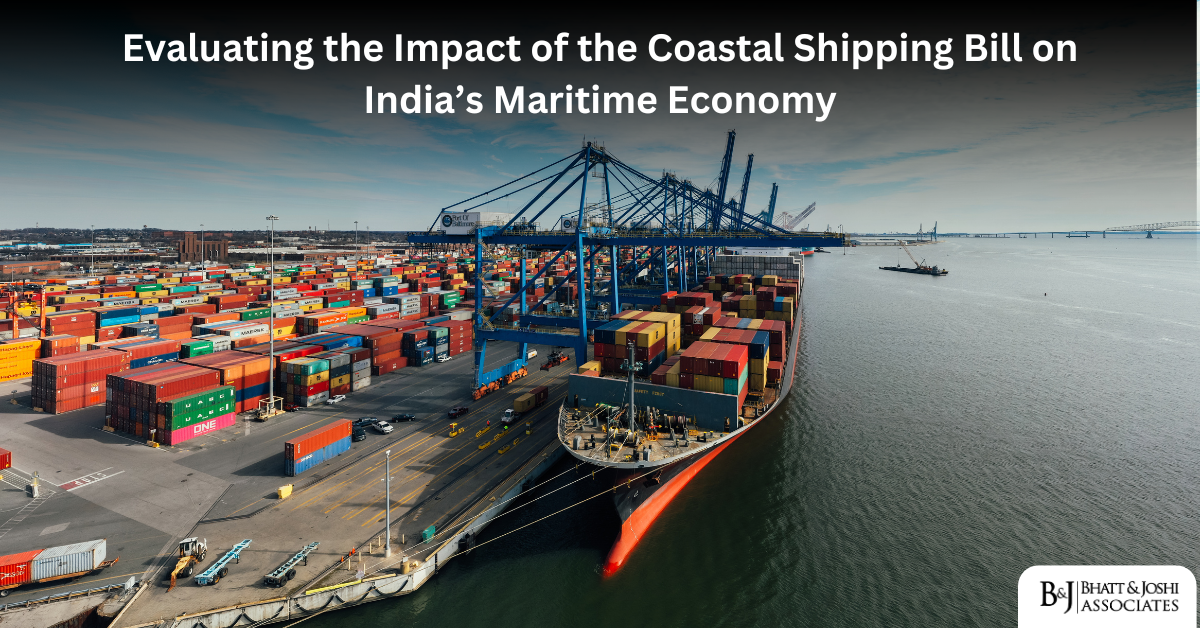Introduction
The maritime sector forms the backbone of international trade and commerce, providing a crucial link for the exchange of goods and services across the globe. In India, a nation with a coastline spanning over 7,500 kilometers, the significance of maritime activities cannot be overstated. Coastal shipping, a subset of maritime trade, has emerged as a vital component of the country’s transport network, offering an economical and environmentally sustainable alternative to road and rail transport. The introduction of the Coastal Shipping Bill in India marks a transformative step in harnessing this potential, with far-reaching implications for the nation’s maritime economy.
The Context and Objectives of the Coastal Shipping Bill
India’s maritime sector has historically been regulated by multiple laws and policies that govern ports, shipping, and inland waterways. The Merchant Shipping Act, 1958, and the Inland Vessels Act, 1917 (repealed and replaced by the Inland Vessels Act, 2021), have been central to regulating maritime activities. However, the fragmented nature of these regulations often led to inefficiencies, redundancies, and legal ambiguities. The Coastal Shipping Bill seeks to address these challenges by consolidating and modernizing the regulatory framework.
The primary objectives of the Coastal Shipping Bill include fostering economic growth through enhanced maritime connectivity, reducing logistical costs, promoting sustainable transportation, and creating a level playing field for stakeholders in the coastal shipping ecosystem. By simplifying and harmonizing the regulatory framework, the Bill aims to attract investments, boost employment opportunities, and enhance the competitiveness of India’s maritime sector in the global arena. Furthermore, it intends to create synergies with India’s broader economic policies such as “Make in India” and “Atmanirbhar Bharat,” providing a significant boost to domestic manufacturing and self-reliance.
Key Provisions of the Coastal Shipping Bill
The Coastal Shipping Bill introduces several progressive provisions designed to revitalize India’s maritime economy. First, it defines coastal shipping as a distinct mode of transport, thereby delineating it from inland and international shipping. This clarity facilitates targeted policy interventions and resource allocation. Second, the Bill emphasizes the use of Indian-built, Indian-flagged, and Indian-owned vessels for coastal operations, promoting domestic shipbuilding and enhancing the self-reliance of the sector.
Additionally, the Bill simplifies the process of obtaining permissions and licenses, reducing bureaucratic hurdles for operators. It also incorporates provisions to promote multimodal transportation by integrating coastal shipping with railways, roadways, and inland waterways. This integration is expected to optimize the logistics chain, reduce transit times, and lower transportation costs.
A noteworthy aspect of the Bill is its focus on incentivizing the adoption of green technologies in the maritime sector. By offering financial and policy incentives for the use of low-emission vessels and alternative fuels, the Bill aligns with India’s commitments under international climate agreements, such as the Paris Accord. Moreover, provisions to enhance safety standards, implement advanced navigation systems, and modernize port infrastructure are crucial elements of the Bill.
Regulation and Oversight of Coastal Shipping
The Coastal Shipping Bill is supported by a robust regulatory framework to ensure compliance and accountability. The Directorate General of Shipping (DGS), the apex body responsible for regulating shipping activities in India, is entrusted with enforcing the provisions of the Bill. The DGS oversees the registration and certification of vessels, safety standards, and environmental compliance.
The Bill also aligns with international maritime conventions, including the International Maritime Organization (IMO) regulations, to ensure that India’s coastal shipping standards are on par with global benchmarks. The adoption of these standards is crucial for fostering international collaboration and promoting sustainable maritime practices. Additionally, the establishment of dedicated coastal shipping corridors, with clearly defined routes and operational guidelines, is expected to enhance efficiency and safety in coastal operations.
Legal Precedents and Case Laws
Several landmark judgments and case laws have shaped the regulatory landscape of India’s maritime sector, influencing the formulation of the Coastal Shipping Bill. The Supreme Court’s ruling in Vishaka & Ors. v. State of Rajasthan (1997) laid the foundation for adopting international conventions into domestic law, a principle that finds relevance in aligning the Bill with IMO standards.
In Bharati Shipyard Ltd. v. Deputy Commissioner of Income Tax (2011), the Supreme Court underscored the importance of promoting the domestic shipbuilding industry. This judgment resonates with the Bill’s emphasis on prioritizing Indian-built vessels for coastal shipping operations. By mandating the use of domestically produced ships, the Bill seeks to bolster India’s manufacturing capabilities and reduce reliance on imports.
Another notable case, Intercontinental Consultants and Technocrats Pvt. Ltd. v. Union of India (2018), highlighted the need for clarity and simplicity in tax structures to avoid disputes and litigation. The Coastal Shipping Bill’s streamlined licensing and regulatory procedures reflect this principle, reducing the compliance burden for operators. Furthermore, cases like Shipping Corporation of India Ltd. v. Machado Brothers (2004) have provided insights into resolving disputes related to coastal shipping, offering a legal framework that the Bill builds upon.
Economic Implications of the Coastal Shipping Bill
The Coastal Shipping Bill is poised to have a transformative impact on India’s maritime economy. One of its most significant benefits is the potential to reduce logistical costs, which currently account for approximately 13-14% of India’s GDP, compared to the global average of 8-9%. Coastal shipping offers a cost-effective alternative to road and rail transport, particularly for bulk cargo such as coal, steel, and cement. By encouraging a modal shift from road and rail to coastal shipping, the Bill can help reduce transportation costs and enhance the competitiveness of Indian goods in international markets.
The Bill also provides a significant boost to the shipbuilding and repair industry. By mandating the use of Indian-built vessels, it creates a steady demand for domestic shipyards, fostering technological innovation and creating employment opportunities. Furthermore, the development of coastal infrastructure, including ports, terminals, and logistics hubs, is expected to attract private investments and stimulate economic growth in coastal regions. The ripple effect of these developments on ancillary industries, such as manufacturing, technology, and services, is likely to be substantial.
Environmental and Social Benefits
In addition to its economic advantages, the Coastal Shipping Bill promotes environmental sustainability. Coastal shipping is inherently more fuel-efficient and emits lower greenhouse gases compared to road and rail transport. The Bill’s emphasis on multimodal transportation further enhances its environmental credentials by optimizing resource utilization and minimizing wastage. Additionally, the encouragement of green shipping practices and the use of cleaner fuels are expected to significantly reduce the maritime sector’s carbon footprint.
The social impact of the Bill is equally noteworthy. By creating jobs in shipbuilding, port operations, and allied sectors, it contributes to the socio-economic development of coastal communities. Moreover, the enhanced connectivity facilitated by coastal shipping improves access to markets and services, fostering inclusive growth. For fishermen and small-scale traders along India’s coastline, improved infrastructure and reduced transportation costs translate to better livelihoods and increased profitability.
Challenges and Criticisms
Despite its many advantages, the Coastal Shipping Bill faces certain challenges and criticisms. One of the primary concerns is the potential resistance from stakeholders in the road and rail transport sectors, who may view the Bill as a threat to their market share. Additionally, the high initial costs associated with developing coastal infrastructure and procuring vessels may deter smaller operators from entering the market.
Another challenge lies in ensuring the effective implementation of the Bill’s provisions. The success of the regulatory framework depends on the efficiency and transparency of enforcement mechanisms, as well as the capacity of the DGS to handle increased responsibilities. Addressing these challenges requires coordinated efforts from the government, industry stakeholders, and regulatory authorities. Moreover, concerns about the adequacy of existing port facilities and the need for substantial investment in modernization and expansion must be addressed.
Global Comparisons and Lessons for India
India can draw valuable lessons from the experiences of other maritime nations in implementing coastal shipping reforms. Countries like the United States, Japan, and Australia have successfully integrated coastal shipping into their transport networks, leveraging its economic and environmental benefits.
For instance, the United States’ Jones Act mandates the use of American-built, American-flagged, and American-crewed vessels for domestic shipping, a policy that aligns with India’s emphasis on self-reliance. Similarly, Japan’s efficient multimodal transport systems offer insights into integrating coastal shipping with other modes of transport. By studying these models, India can fine-tune its policies and address potential challenges in implementing the Coastal Shipping Bill.
Conclusion and the Road Ahead
The Coastal Shipping Bill represents a landmark reform in India’s maritime sector, offering a comprehensive framework to unlock the potential of coastal shipping. Its economic, environmental, and social benefits position it as a critical enabler of India’s aspirations for sustainable and inclusive growth. However, realizing these benefits requires addressing implementation challenges, fostering collaboration among stakeholders, and drawing lessons from global best practices.
As India moves forward with the implementation of the Coastal Shipping Bill, continuous monitoring and evaluation will be crucial to ensure its success. By aligning the regulatory framework with industry needs and global standards, the Bill can serve as a catalyst for transforming India’s maritime economy and strengthening its position as a leading maritime nation. Furthermore, sustained investment in infrastructure, technology, and human capital will be essential to fully realize the transformative potential of the Bill. By adopting a holistic and collaborative approach, India can unlock the vast opportunities offered by coastal shipping, driving long-term growth and sustainability in its maritime sector.














